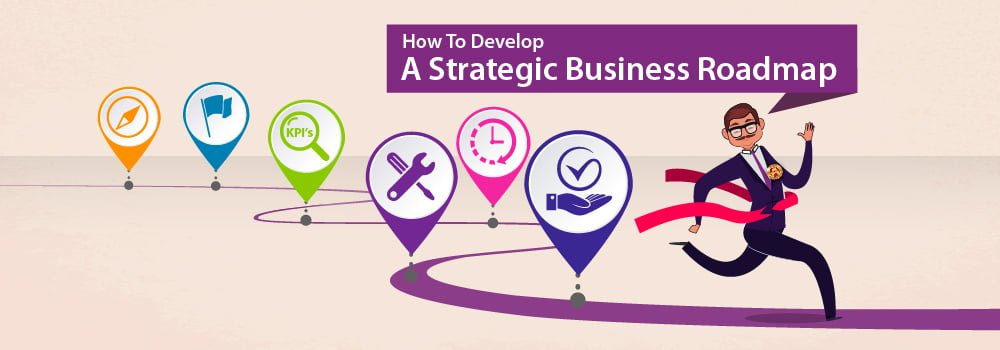|
Getting your Trinity Audio player ready...
|
Organizations invest hundreds of billions in developing strategies, yet many fail, wondered why? Lack of successful implementation.
While Strategy Implementation remains a top priority for executives, Survey after survey report that fewer than 15% of organizations worldwide reported successful implementation of their strategic initiatives.
Multiple surveys have reported a failure rate of 60% and 90% in strategic implementation, suggesting a considerable gap between a firm’s expectations and desired outcomes. Thus, developing a strategic business roadmap is crucial to improving implementation success rates. But what is a strategic roadmap, and why does your organization need it and how to create a roadmap for business?
Why Does a Company Need a Strategic Business Roadmap?
Often, the leaders, employees, and stakeholders are on the same page about the organization’s future, causing a state of disarray across the company.
The State of leadership development 2020 surveyed 21,008 employees to assess leaders’ effectiveness. They found that only 29% of employees felt that their leader’s vision for the future aligned with that of the organization. Furthermore, leaders often make decisions on the fly that may not necessarily be optimized for the organization’s long-term success and growth.
A strategic business roadmap can help an organization avoid these challenges by providing a clear path to achieve its goals and ensuring that all actions align with the plan.
What is a Strategic Roadmap? How to create a roadmap for business
Simply put, a strategic roadmap is a map that paves the way for an organization’s immediate and long-term success. Not only does the roadmap show where your company is and the quickest way to your goals, but it also helps shorten the timeline since employees waste less time figuring out things on the go.
A strategic business roadmap enables organizations to pinpoint the choices they need to make for long-term success. A strategic roadmap ensures that founders can see through the operating fog and paint a clear vision for everyone in the company. If implemented right, it enables employees across the cadre to make quality decisions that align with the company’s objectives and serves as a reference point for employees, managers, stakeholders, and other interested parties.
Does your organization have a strategic roadmap?
Not yet?
Here is a step-by-step guide for developing one for your organization.
Building a strategic business roadmap can seem daunting at the start, but it doesn’t necessarily have to be.
Here is a simple framework to help you how to create a roadmap for business
- Defining Your Organization “Compass”-> The first step in developing a strategic business plan for an organization is defining the vision, mission, and core values. The mission, vision, and core values form the “compass” to guide your organization’s way forward. Understanding the organization’s vision, mission, and core values enable employees to evaluate decisions and actions that align with the long-term goals and objectives and decide accordingly.
- Identify Your Destination-> Once you have your “compass” in place, the next step is defining the destination- the long-term goals. Where does the company want to be in, say, 5- 10 years?
Goals are broad, high-level statements describing the outcomes to be achieved.
On the other hand, objectives are more specific and measurable statements that describe the actions that need to be taken to achieve the goals – increasing sales by X%, reducing costs by Y%, or reducing the organizational environmental footprint by Z%, etc.
- Measure Goals Through Processes-> Once the goals and objectives of an organization have been identified, a metric is needed to track progress which means defining Key Performing Indicators (KPIs). KPIs are metrics that help measure the performance of a business strategy/initiative in achieving the organization’s objectives. For instance, if an organization aims to acquire X new customers next year, it should consider what this would mean for its marketing, sales, and R&D strategy to help accomplish these objectives.
- Create a Map -> Once all the processes have been designed, creating a timeline for your strategic roadmap is essential. The timeline ensures that the “Map” will lead the organization to its goals. To achieve this, leaders need to set a timeline for each objective, working backwards to determine the timeframe for each goal. This step also involves setting milestones and scheduling time to periodically track KPIs to ensure that the organization is on track to achieve its objectives and make the necessary adjustments.
- Gather The Right Tools -> Once the strategic roadmap is outlined, the next step is to find the resources to execute the roadmap. Identify ad put the right team and systems in place across departments. It would mean taking a hard look at one’s financial resources, Human Resources, Sales & Marketing resources, technology, or other assets. This step is crucial, as one size does not fit all and is unique for each entity. Organizations need to identify their strengths and weaknesses to bolster resources lacking talent.
- Assign Responsibilities-> Once the resources have been allocated specifically for each project, assigning tasks and responsibilities to individuals/teams is the next critical step. It requires business objectives to be broken down into specific, actionable tasks to help team members understand what is needed to be done to contribute to the organization’s long-term success.
- Measure & course correct -> Put in measures to track progress across levels. Actively address areas where the team is behind and proactively course correct.
Conclusion
A well-designed strategic roadmap provides a clear and concise plan to help an organization achieve its goals and objectives and stay focused and on track.
So what are you waiting for? Set out on your journey to success and create a strategic roadmap for your organization today!!?
If you feel challenged following the steps outlined above, Reach us or comment in the comment box, and I will be more than happy to clarify.
